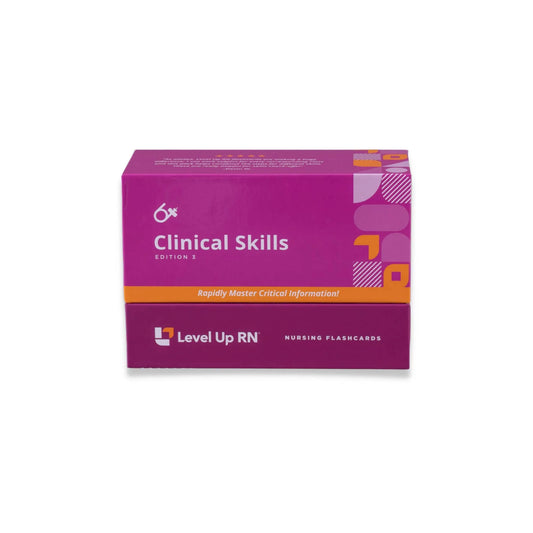Clinical Skills - Emptying a Closed Drain
A demonstration on how to empty two types of closed drains. Plus, tips about how closed drains work and how to manage them for your patients.
Full Transcript: Clinical Skills - Emptying a Closed Drain
Full Transcript: Clinical Skills - Emptying a Closed Drain
Hi, I'm Ellis Parker. And in this video, I'll be demonstrating how to empty a closed drain. I'll be using the steps that are on our clinical nursing skills cards. So if you have this deck, grab the card and you can follow along with me. If you don't have the deck and you're interested in checking it out, head on over to LevelUpRN.com. After the demonstration, I'll be coming back here to just go over a couple more things with you.
To empty a closed drainage system, I've already done my hand hygiene, and I've put on my gloves to protect myself. So this first one that we'll work with, I like to refer to as the grenade type. Right? It looks very much like a little grenade, and you can see it's got some drainage force in there. So I'm going to open this cap away from my body so that as it's opening, if anything splashes out, it's not going to be on my face. So just pop that cap open. Then I'm going to get a collection cup and just empty the drainage out into the collection cup. I will be measuring this. I'll also be noting and documenting the color, the consistency, if there's any odor. Right? So I do want to look at it. I want to set it on a solid surface and measure it. And then honestly, we just put this in a toilet and flush it to waste it. So I'm going to take this into the bathroom and discard it.
I then need to reset this because it holds on its own suction. So I just collapse it like this. So I squeeze it. Now I pop the cap back on. And when I let go of it, it will slowly start expanding while pulling that drainage back out of the wound. So if it's not collapsed or charged is what it's sometimes called, then it's not actually doing anything. So if you come into the room and it just looks like this, it's not actively doing anything, and you would need to uncap it, recharge it, and set it back up. And so we want to make sure that we're emptying these when they're about half full because the fuller it gets, the less likely it is to actually be suctioning. And in case you haven't seen the other end of it, this is the end that goes into a patient. Now, I always think this is interesting. So it does turn into tubing before it reaches the drain, but it's just this flat piece of rubber that has holes in it so that all the drainage can be collected. So this would be placed by the surgeon into the wound bed. So this is one type of closed drain.
Our other type of closed drain is an accordion drain. So you can see, inside, it's got springs. And they're just metal springs, and it works exactly the same. This piece would be inside of my patient collecting the drainage. It would flow into this piece. I would uncap it facing away from me, and I would empty it into a container. And then I do literally have to compress it, and it always makes a funny squeak. So I'm going to completely compress it, recap it, and then as that accordion pushes itself back out, it's suction-pulling that drainage back into this bag. And that's how you empty a closed drain system.
During that demonstration, I showed you the different drains, their tubing, and the end of the drain, but I want to just give you a visual of what it would look like at a clinical setting. So here, I've got the end of the drain inside of my patient's wound. It would likely be covered with some kind of dressing, the tubing, and then it goes into my canister. So in a real situation, I would come to my patient, perhaps assess the site and the drainage, and then I would empty the canister. So I would do it all at the patient's bedside. I have seen students disconnect the drain and empty it elsewhere, but you never want to do that. It's unfortunately really easy to do. You just pull on this and it disconnects, and so maybe that's why students think that that's appropriate. So they can disconnect it, go empty it, bring it back, and reconnect it, but that's actually not the correct way to do this. I would do it at the bedside. I would bring a container, a graduated cylinder of some sort, open my port, and empty it at the bedside. And then, of course, collapse my drain, and close my port.
And that brings me to my next point of this, of course, is going to re-expand automatically. It makes some lovely music for us because there's no counter pressure because the end of it's not actually in a wound. So during these demonstrations, the drains are going to open automatically, but of course, in a realistic setting, this would take a few hours to actually fully expand. So make sure that you do all of this care at the patient's bedside. Never disconnect the drain from the drain tubing.
And then just a final note. It is best practice to actually clip this somewhere onto the patient's gown so that there's no pulling at the insertion site. You want this to not be hanging or potentially get caught on something, so it's best practice to go ahead and secure it to the patient's gown in some way.


